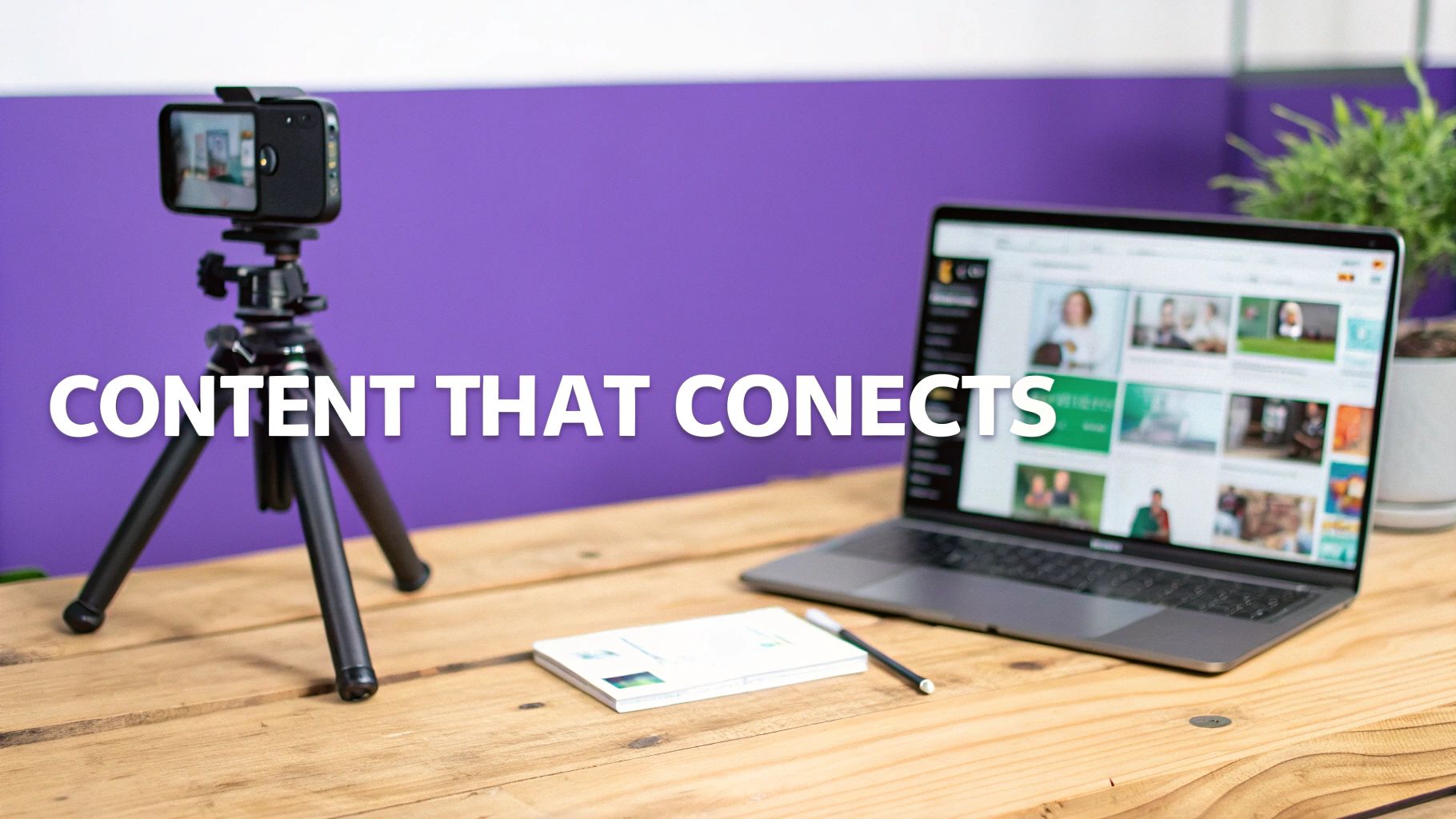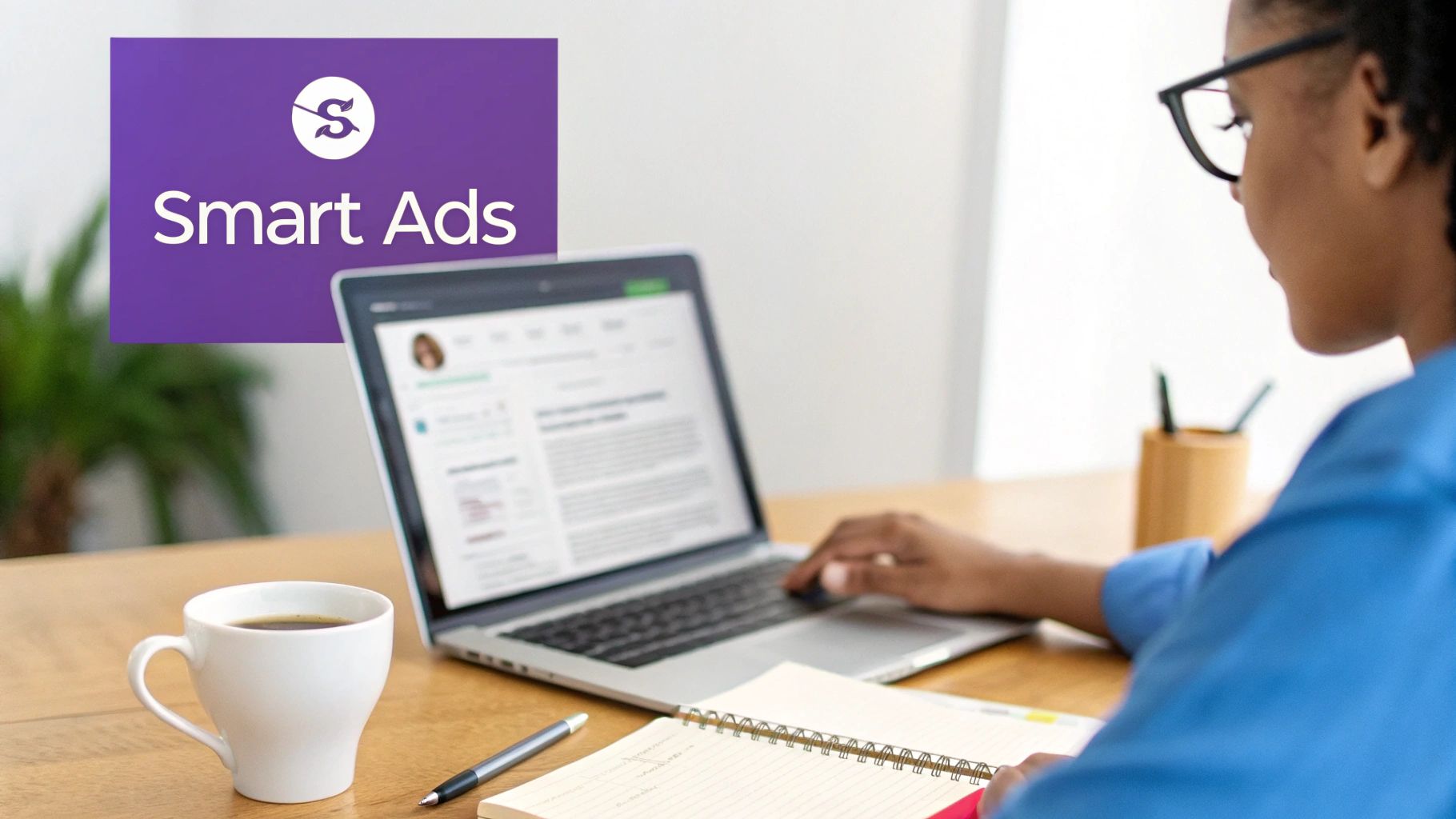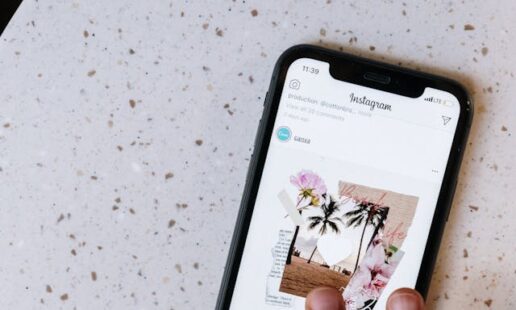Social Media Marketing Strategies for Small Businesses

Winging it on social media just doesn’t cut it anymore. A solid plan is what separates the businesses that get real results from those just shouting into the void. It all starts by figuring out what you want to achieve, then getting crystal clear on who you’re talking to and where they hang out online. This is how you turn social media from a time-suck into a genuine growth engine for your business.
Building Your Foundation for Social Media Success

It’s tempting to jump on every new platform, but that’s a classic mistake that burns through your time and money. Before you even draft a single post, you have to ask the most important question: what’s the point?
Your social media goals can’t just be about looking popular; they need to be directly wired into your actual business objectives. We’re talking about real results, not just chasing vanity metrics like follower counts.
Define What Success Looks Like
First things first, outline what a “win” actually looks like for you. Are you trying to get more eyeballs on your online store? Do you need more people walking through the door of your brick-and-mortar shop? Or is it all about building a loyal crew of fans who rave about your brand?
Here are a few common goals I see small businesses focus on:
- Boost Brand Awareness: Just getting your name out there so more potential customers know you exist.
- Drive Website Traffic: Funneling people from your social profiles over to your blog, product pages, or contact form.
- Generate Leads and Sales: Turning followers directly into customers with promotions or social shopping features.
- Build Community Engagement: Creating a real connection where customers feel like they’re part of something.
When you have this clarity, every other decision becomes a hundred times easier. For example, if your main goal is local foot traffic, pouring your energy into Facebook Events and local group engagement is a much smarter play than trying to create the next viral TikTok dance.
The temptation to take shortcuts can be strong, but it rarely aligns with building a real, paying customer base. For instance, if you’re looking for genuine growth on Instagram, it’s better to understand the platform’s nuances. That’s why we put together this guide on how to grow Instagram followers organically.
Get to Know Your Ideal Customer
Okay, so you’ve got your “why.” Now it’s time to figure out your “who.”
This is where a detailed customer persona becomes your secret weapon. I’m not just talking about basic demographics like age and city. You need to go deeper.
A great customer persona feels like a real person. You should know their hobbies, their pain points, what makes them laugh, and most importantly, how they use social media.
Drill down by asking yourself a few key questions:
- Where do they scroll? Are they on Facebook catching up with family, or are they on Instagram looking for design inspiration?
- What content makes them stop? What do they save, share, or bother to comment on?
- Who do they follow? Think influencers, other brands in your space, or local community leaders.
- What problem are you solving for them? Get to the core of how your business makes their life better.
Understanding this stuff is an absolute game-changer. It means your content will land with the right people, making every ounce of effort more effective.
Platform Focus Based on Small Business Goals
Choosing where to spend your time is crucial. You can’t be everywhere at once, so pick the platforms that make the most sense for your specific goals. This table should give you a quick cheat sheet.
| Primary Goal | Best Platform Choice | Why It Works |
|---|---|---|
| Build a Visual Brand & Sell Products | Perfect for showcasing products with high-quality images, Reels, and Stories. Instagram Shopping makes it easy to sell directly. | |
| Drive Website Traffic & Share Info | Facebook or Pinterest | Facebook’s linking capabilities are strong, and its user base is huge. Pinterest is a powerhouse for driving traffic to blogs and e-commerce sites. |
| B2B Lead Generation & Networking | The go-to professional network. Ideal for connecting with other businesses, sharing industry expertise, and finding decision-makers. | |
| Reach a Younger Audience with Short Video | TikTok or Instagram Reels | These platforms are king for engaging Gen Z and Millennials with creative, short-form video content that feels authentic and entertaining. |
Think of this as your starting point. You don’t need to be on all of them. Pick one or two where your ideal customer lives and that align with what you’re trying to achieve, and go all-in there. You can always expand later once you’ve found your groove.
Crafting Content That Actually Connects

Let’s be real for a second. If you feel like you’re just churning out content to check a box, your audience can probably feel it, too. When your posts start sounding more like robotic sales pitches than real conversations, it’s a sign that something needs to change.
The mission isn’t just to fill up a content calendar. It’s to create stuff that makes people stop scrolling and actually feel something. This is where human-centric content pillars come in. Think of these as the core themes you’ll revisit, giving your feed variety while keeping everything grounded in your brand’s true voice. Ditching the constant “buy now” message for genuine connection is one of the smartest social media marketing strategies for small businesses you can adopt.
The Power of Human-Centric Content
People want to connect with other people, not faceless logos. Your content is your chance to show them the real humans running the show. This is how you build trust and turn passive followers into a loyal community that actually cares.
An easy place to start? Pull back the curtain. Show your audience the messy, unpolished reality behind your business. A quick video of you packing an order, a candid shot of your team brainstorming, or even a story about a mistake you learned from can be incredibly powerful.
Another pillar is to put the spotlight on your customers. User-generated content (UGC) is pure gold. When a customer tags you in a post showing off your product, reshare it! It’s a powerful testimonial that makes that customer feel seen and encourages others to share their experiences, too.
The most impactful content rarely feels like marketing at all. It feels like a genuine peek into your world, an answer to a question, or a shared moment of celebration.
Finally, just be genuinely helpful. Instead of only posting about your product, show how it solves a real-world problem. A local bakery, for instance, could share a quick tip on how to properly store bread to keep it fresh. That kind of content positions you as an expert and builds goodwill long before you ever ask for a sale.
How to Create Simple Short-Form Videos
For small businesses, short-form video on platforms like Instagram Reels and TikTok is pretty much non-negotiable for growth right now. And no, you don’t need a professional camera crew-your smartphone is more than enough to get started.
Here’s a simple “how to” guide for your first video:
- Brainstorm Simple Ideas: Don’t overthink it. Your first videos can be a quick tour of your workspace, you answering a frequently asked question on camera, or a time-lapse of your product being made.
- Use In-App Tools: Both Instagram and TikTok have surprisingly powerful built-in editors. You can easily trim clips, add text on screen, and-most importantly-use trending audio. Tapping into a popular sound can give your video’s reach a serious boost.
- Nail the First 3 Seconds: You have to grab attention immediately. Start with a strong visual hook or a text overlay that asks an intriguing question to stop the scroll.
- Keep it Authentic: Forget about being perfect. People on these platforms crave content that feels real and unpolished. A little camera shake or some background noise often makes your content feel more relatable, not less professional.
Creating this mix of content does more than just fill your feed; it builds a genuine community. A community is far more valuable than a simple follower count. While it might be tempting to look for quick fixes, nothing beats authentic connection. Some services promise instant growth, and a common question is how to buy Instagram followers. But that strategy usually backfires, leaving you with an audience of bots that will never engage or buy from you.
True, sustainable growth comes from creating content that really connects with people. For a deeper look at this, you can learn more about practical ways to boost Instagram engagement that deliver actual results.
How to Grow Your Small Business on Instagram
Instagram can be an absolute powerhouse for small businesses, but it’s way too easy to feel like you’re just shouting into the void. If you really want to see growth, you need a game plan that goes far beyond just posting pretty pictures. It all comes down to a smart mix of content, truly understanding who you’re talking to, and being relentless with your engagement.
Figuring out Instagram is one of the most powerful social media marketing strategies for small businesses because it’s where people are actively looking to discover and connect with new brands. The secret is to treat your page less like a billboard and more like the heart of a community.
How to Make Your Profile Discoverable
Before anyone even sees your content, they land on your profile. Think of your Instagram bio as your digital storefront-it has to be crystal clear, searchable, and grab their attention in a matter of seconds.
Let’s start with your handle and name. Your handle (@yourbusiness) should be simple and easy to remember. Your name field, however, is a secret weapon because it’s searchable. Don’t just put your business name there. Pack it with a keyword. Instead of “The Sweet Spot,” try “Oakland Custom Cakes.” See the difference?
Next, your bio needs to immediately answer three critical questions:
- Who you are: A quick, personality-packed description of your business.
- What you do: State exactly what product or service you sell. No fluff.
- What you want them to do: Give them a strong call to action (CTA). Something like “Shop our new collection” or “Book a free consultation” that points them right to the link in your bio.
Your profile picture should be your logo-high-quality and instantly recognizable. And please, don’t sleep on your Story Highlights! Use them as a visual FAQ section, showcasing your best products, glowing customer testimonials, or fun behind-the-scenes moments.
The Great Debate: Buy Instagram Followers vs. Organic Growth
Alright, let’s just get this out of the way. The temptation to buy Instagram followers is real. I get it. You’re starting from zero, and you want to look credible. It feels like a quick fix to a painfully slow problem.
Here’s the hard truth: it’s a terrible, horrible, no-good, very bad idea. Buying followers gets you a number, but it absolutely does not get you a community. Those “followers” are almost always bots or ghost accounts. They will never like your posts, comment on your Stories, or-and this is the big one-buy your products.
Buying followers is like renting a crowd for a party no one wants to attend. It looks impressive from a distance, but up close, it’s just empty space. The real damage is to your engagement rate.
When your posts get zero interaction from your thousands of “followers,” the Instagram algorithm flags your content as boring. What happens next? It stops showing your posts to the real people who actually chose to follow you. You essentially pay money to become invisible.
Genuine growth takes time, but it builds an audience that actually cares. Focus on these organic methods instead:
- Laser-Focused Hashtags: Ditch massive tags like #smallbusiness. Get specific with niche, community, and location-based hashtags. Think #brooklynvintagefinds or #handmadepotterystudio.
- Local Collaborations: Team up with a non-competing local business. Run a joint giveaway or do a shoutout swap. You both get exposed to a fresh, highly relevant audience.
- Engaging Contests: Create a contest that encourages real interaction. Ask followers to comment with their favorite product or tag a friend who would love your brand.
How to Build a Simple (and Effective) Content Calendar
On Instagram, consistency is everything. A simple content calendar is your best friend-it prevents those last-minute panic posts and ensures you’re sharing a healthy mix of content that serves both your audience and your business goals.
Your calendar doesn’t need to be fancy. A basic spreadsheet or even a notes app will work just fine. Plan your content around a few core pillars. For example, a local coffee shop’s pillars might look like this:
- Promotional: Highlighting a “drink of the week” or a special offer.
- Educational: A quick Reel showing how to make the perfect pour-over coffee at home.
- Community: Sharing a photo of a regular customer (with their permission, of course!).
- Behind-the-Scenes: A Story showing the team prepping for the morning rush.
Try to find a good balance between Reels, Stories, and static posts in your feed. Reels are your number one tool for reaching new audiences, while Stories are perfect for nurturing the bond you have with your current followers. For a deeper dive, check out our guide on 9 practical tips for boosting Instagram engagement in 2025.
The money businesses are pouring into social ads is skyrocketing, with global spending projected to hit a massive $276.7 billion in 2025. This just goes to show how vital it is for small businesses to pair their organic work with smart, low-budget advertising to get seen. And even though we’ve seen a slight dip in overall Instagram engagement, using features like Instagram Shopping and interactive Stories is still a game-changer for connecting with customers. You can dig into more social media advertising trends on sproutsocial.com.
Choosing the Right Platforms Beyond Instagram
Look, Instagram is a powerhouse, no question. But going all-in on a single platform is a massive gamble. The smartest move you can make is to diversify. This isn’t about stretching yourself thin trying to be everywhere; it’s about strategically planting your flag where your ideal customers actually hang out.
Putting all your eggs in one basket leaves you totally exposed. An algorithm tweak, a new feature that tanks your reach, or a sudden shift in user trends could kneecap your business overnight. By exploring other platforms, you’re not just finding new customers-you’re building a more resilient brand.
To help you decide where to focus your energy, let’s break down the major players and what they’re best for.
Platform Strengths for Small Businesses
| Platform | Best For (Industry) | Key Content Type | Primary Audience |
|---|---|---|---|
| E-commerce, Fashion, Food, Travel, Local Services | High-quality photos, Reels, Stories | Broad; Strong with Millennials & Gen Z | |
| TikTok | Any B2C with a creative angle, Entertainment, Fashion | Short-form vertical video, trends | Gen Z & younger Millennials |
| Local Businesses, Professional Services, Events | Community posts, live video, ads | Broad; Strong with Gen X & Boomers | |
| B2B, Consulting, Tech, Professional Services | Articles, text posts, professional video | Professionals, decision-makers, job seekers | |
| Home Decor, DIY, Wedding, Food, Fashion | High-quality vertical images, infographics | Predominantly female, planners & shoppers |
This table is your starting point. Don’t feel pressured to be on every platform. Pick one or two that genuinely align with your business and master them first.
Ride the Wave with TikTok
You simply can’t ignore TikTok’s momentum, especially if you want to reach a younger, hyper-engaged audience. The magic is in its interest-based algorithm-it’s not about who you know, it’s about the quality of your content. A brand new account can genuinely go viral.
Success on TikTok means dropping the corporate act, embracing authenticity, and jumping on trends fast.
Here’s how to get started:
- Become a Student of the ‘For You’ Page: Seriously, just scroll. See what sounds, video formats, and challenges are popping off in your niche.
- Create Value, Not Commercials: Think like a creator. Film a behind-the-scenes look at how you make your product, share a killer 30-second tip, or make a funny, relatable skit about your industry.
- Jump on Trending Audio: Using a popular sound is one of the fastest shortcuts to getting your video in front of a massive, fresh audience.
The goal is to make content that feels like it belongs there-a little raw, totally creative, and 100% genuine.
This infographic breaks down the essential cycle for growing organically on any visual platform. It’s a constant loop of optimizing, creating, and engaging.
As you can see, a solid profile, consistent content, and real community engagement all feed into each other, creating a cycle that drives organic growth.
Build a Community with Facebook Groups
While the main Facebook feed can feel like shouting into the void, Facebook Groups are where real community happens. For local businesses, this is an untapped goldmine. You can start your own group for your biggest fans or, even better, become a valuable member of existing local groups.
Imagine you’re a local pet groomer. Instead of spamming your services, you join the “Town Dog Lovers” group. You start answering questions about pet care and sharing helpful advice-all without a sales pitch. You quickly become the trusted local expert. Who do you think they’ll call when their pup needs a trim? Exactly.
Establish Authority on LinkedIn
If you’re a B2B business, LinkedIn is not optional. It’s the digital boardroom where professionals network, share knowledge, and make buying decisions. Here’s a little secret: your personal profile often carries more weight than your company page.
Think of your LinkedIn profile as your professional landing page. It needs to scream, “This is who I help and how I do it.”
Ditch the boring job title. Instead of “Owner at ABC Consulting,” try something like, “I Help Small Businesses Streamline Their Operations | Project Management Pro.” Share articles that offer real insight, drop thoughtful comments on other people’s posts, and connect with potential clients like a human, not a bot.
Juggling all these platforms can feel like a circus act. That’s where finding the right social media management tools for small business can save your sanity and keep you consistent. And don’t sleep on TikTok’s power-its engagement rates are incredible. In 2024, the average organic engagement rate hovered around 2.5%, but smaller accounts often saw rates as high as 7.5%. For more data, check out these social media marketing statistics from sprinklr.com.
Smart Advertising and Analytics on a Budget

Jumping into the world of paid ads can feel like walking into a casino-intimidating and seriously expensive. But it doesn’t have to be. For a small business, social media advertising isn’t about outspending the big players; it’s about being smarter with every single dollar.
You don’t need a massive budget to see real results. The secret is to start small, target with laser precision, and pour a little fuel on what’s already working for you organically. This approach turns advertising from a gamble into a calculated investment, making it one of the most powerful social media marketing strategies for small businesses.
How to Run Your First Low-Budget Ad Campaign
Ready to dip your toes in the water? The simplest and most effective way to start is by boosting one of your best-performing organic posts. Go through your feed and find a post that already has great likes, comments, and shares-this is your proof that the content resonates with people.
Boosting it is easy. With just a few clicks, you can put a small budget behind it-think $5 to $10 a day-to push it out to a wider, yet still highly targeted, audience. You’re not reinventing the wheel; you’re just putting gas in a car that’s already proven it can win the race.
Another brilliant low-cost strategy is the local awareness ad. If you have a physical storefront, like a cafe or boutique, you can set up an ad that targets people within a specific radius of your business. Imagine drawing a 5-mile circle around your shop on a map and showing your ad only to those people. It’s a direct and incredibly cost-effective way to get in front of the folks most likely to walk through your door.
How to Understand Your Audience Without a PhD
The real magic of social media ads is in the targeting. You can get incredibly specific about who sees your ad, which means you’re not wasting money on people who will never become customers. One of the most potent tools in your arsenal for this is creating a Custom Audience.
Here’s a simple “how to” guide for using them:
- Website Visitors: You can show ads to people who have recently visited your website. They’re already familiar with your brand, making them much easier to persuade.
- Email List: Have an email newsletter? You can upload that list and show your subscribers exclusive ads. It’s an awesome way to reward your most loyal followers.
- Engagement Audience: This one is a goldmine. You can create an audience of people who have recently liked, commented on, or saved your Instagram or Facebook posts. They’ve literally raised their hand to say they’re interested.
These audiences are “warm,” meaning they’re not total strangers. Advertising to them is like having a friendly conversation with someone you’ve already met, rather than shouting at a crowd of strangers on the street.
Analytics That Actually Matter
Now for the fun part-seeing what’s working. Forget about getting lost in a sea of confusing charts. You only need to track a few key metrics to understand if your strategy is actually paying off.
Start by digging into the free, built-in analytics tools right on the platforms-Instagram calls it “Insights,” and it’s on Facebook too. They’re surprisingly powerful and give you everything you need to know.
Your social media analytics are not a report card; they are a road map. They don’t just tell you how you did-they tell you what to do next.
Here are the numbers you should actually care about:
- Engagement Rate: This is the big one. It’s the percentage of people who saw your post and actually did something (liked, commented, shared, saved). A high engagement rate tells the algorithm your content is valuable, which earns you more organic reach.
- Click-Through Rate (CTR): For ads with a link, this tells you how many people who saw the ad actually clicked on it. If your CTR is low, it might be a sign that your ad copy or visual isn’t compelling enough to stop the scroll.
- Reach vs. Impressions: Reach is the number of unique people who saw your content. Impressions are the total number of times it was seen. If your impressions are way higher than your reach, it means your followers are seeing your posts multiple times-a fantastic sign of sticky content.
By checking these simple metrics weekly, you can quickly spot trends. Is that Reel about packing orders getting tons of saves? Make more of those. Did your ad for a new product get a killer CTR? It might be time to put a little more budget behind it. Ultimately, understanding these numbers is crucial, and you can learn more about how to measure social media ROI to connect your efforts directly to your bottom line.
Your Top Social Media Questions, Answered
When you’re diving into social media for your business, a lot of questions pop up. It’s totally normal. Let’s cut through the noise and tackle some of the most common ones I hear from small business owners.
So, How Often Should I Actually Be Posting?
This is probably the number one question I get, and the honest answer is: consistency beats frequency, every single time. It’s far better to show up with three amazing, value-packed posts a week than to spam your followers’ feeds with seven mediocre ones just to hit a quota.
If you’re just getting started, a great goal is 3-5 high-quality posts per week on your main channel, whether that’s Instagram or Facebook. For quicker content like Stories or TikToks, you can definitely post more-even daily-since that content is designed to be more ephemeral and in-the-moment.
The real secret is to find a rhythm you can maintain without burning yourself out. Start there, and then pay close attention to your analytics. They’ll tell you everything you need to know about when your audience is online and what they want to see from you. Let that data be your guide.
Is Buying Instagram Followers Ever a Good Idea?
I’m just going to be blunt here: buying Instagram followers is a terrible idea for your long-term growth. I get the temptation. You’re starting from scratch, and that little follower number feels like it’s holding you back. A quick boost seems like an easy way to build social proof.
But here’s what really happens when you buy Instagram followers: you get a list of bots and ghost accounts. These aren’t potential customers. They will never like your posts, leave a thoughtful comment, share your content, or, most importantly, buy from you.
What’s worse is that it actively tanks your engagement rate. The Instagram algorithm sees you have thousands of followers but only a tiny handful are interacting. The signal this sends is that your content must be boring, so it stops showing it to the real people who follow you.
You literally pay to become invisible to the audience that matters. Plus, savvy users can spot an account full of fakes from a mile away, and it instantly shatters your credibility. Instead of buying followers, put that money toward a small, targeted ad campaign or just spend the time creating one more piece of killer content. It’s a slower burn, but the results are real.
What Are the Best Free Tools for Managing Social Media?
You absolutely do not need a massive budget to get a handle on your social media. Some of the most powerful tools out there are completely free and perfect for getting your strategy off the ground.
Here are my must-haves for anyone starting out:
- Meta Business Suite: If you’re on Facebook or Instagram, this is non-negotiable. It’s Meta’s own free platform that lets you schedule posts and Stories, handle DMs from both apps in one inbox, and dive into some seriously useful analytics.
- Canva: This is a total game-changer for creating content. Even on the free plan, Canva gives you a mountain of professional templates for graphics, carousels, and even simple video edits. You don’t need a design degree to make something that looks incredible.
- In-App Analytics: Don’t sleep on the free data each platform gives you. Instagram Insights, for instance, is packed with info on your audience demographics, when they’re most active, and which of your posts are hitting the mark. It’s all right there, for free.
Start with this core trio. You can build a rock-solid workflow and only look at paid tools once you’ve outgrown what these free powerhouses can do for you.
Ready to grow your Instagram audience with real, engaged followers who actually care about your brand? Hexrate uses an AI-powered growth engine to connect your content with the right people-no bots, no fake accounts, just genuine visibility. Start your 7-day trial today!
Smart marketers love Hexrate!
Start growing today.
Stop stressing about your Instagram account - our winning growth tactics are time-tested to help you achieve real results – fast & guaranteed!
Get started



